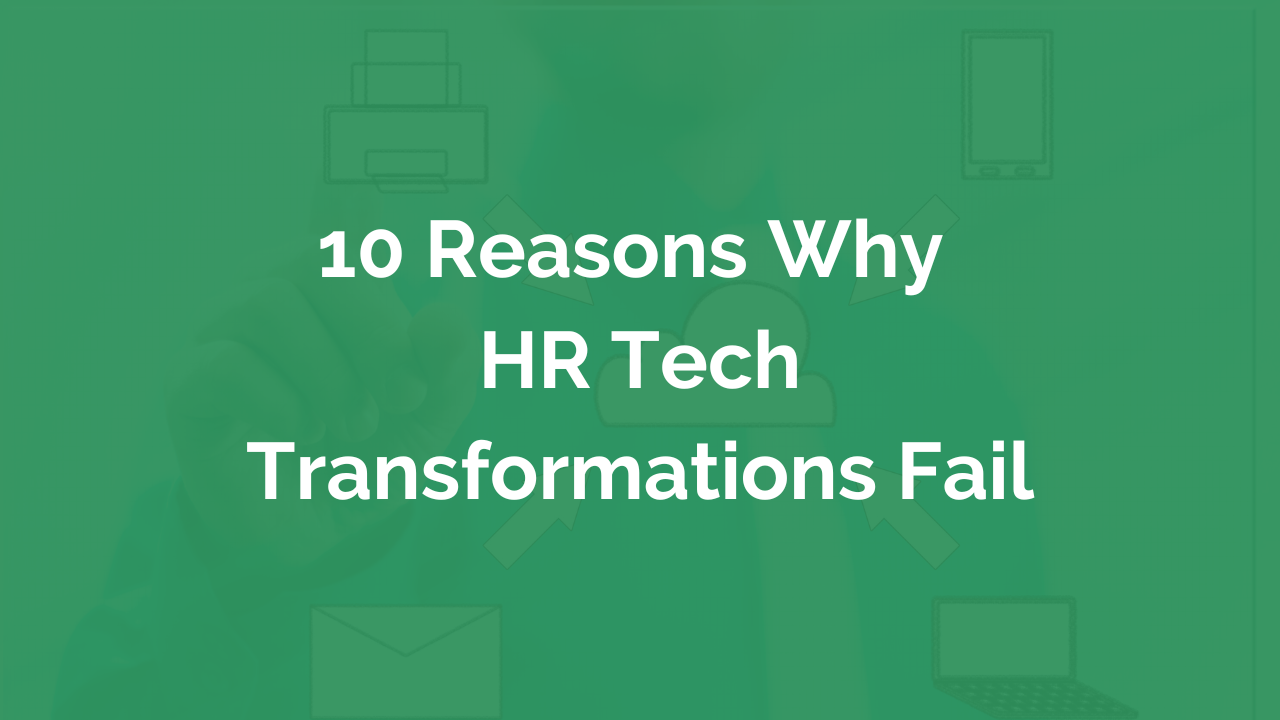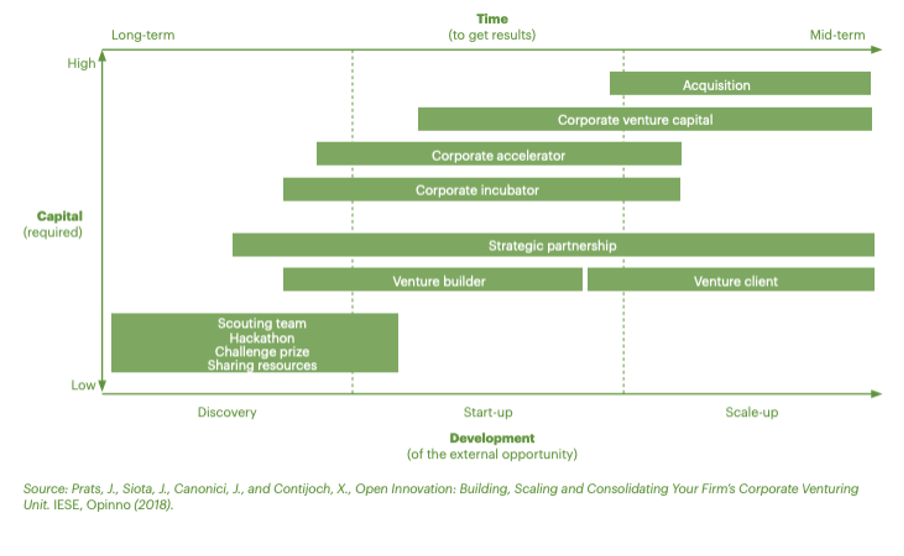10 Reasons Why HR Tech Transformations Fail
HR practitioners at all levels wear many hats in the context of initiating a digital transformation of the workplace; they are the first users of the technology within the organisation and are data-driven researchers of new technologies that enable the People strategy. They are the storytellers to the decision makers, motivating them to invest in the tech. And they are the champions of change, educating and encouraging the employees to adopt the new systems, thus impacting the employee experience.
Meanwhile, according to BCG, only about 30% of companies navigate a digital transformation successfully. As for any other digitalisation projects, putting in the work to get HR digital transformation right to have it fail is, first and foremost, frustrating. There is a loss of money and time with tech that does not perform properly, or nobody uses as well as the problem that it was put in place to solve, still raising havoc in the organisation.
Let's now consider the following scenario:
Not so long ago and not so far away in the HR Tech Galaxy…
Peter, a seasoned CHRO in a large financial organisation, had convinced the Board to invest in a 'next-gen platform' for Talent Management. After 18 months of complex and intensive implementation, the Leadership Team was convinced to allocate another substantial part of their annual budget to add an extra layer of tech for more advanced people analytics.
Eventually, that integrated solution went live six months ago, but only a few initiated experts have used it to provide tons of reporting on attrition. To prevent more bottle-necks and to boost larger adoption, the Leadership Team has recently decided to organise a 'Learning Day' where key features of the tool would be shown off and every HR employee would be invited to complete an e-learning module created by volunteers from the People Analytics Team (the same who are generating a high volume of reporting!).
No need to be an HR Transformation Jedi to guess the outcomes of this project…
But what could have gone wrong?
If you are at the place Peter was and ready to take on the mission to introduce new technology, be aware of why it could fail. From the generic scenario above, there are ten (probably more) potential reasons that the project Peter was passionate about did not bring the results he was hoping for. With proper preparation, you can take the steps needed to run a successful transformation and avoid the challenges that can derail the best-intended efforts.
No Alignment on Current Business Imperatives
When considering technology, getting the right tech or software at the right time is important. Indeed, some items are on the wish list but will not generally tackle the most pressing issues the business is currently facing. Look to ask the right questions to determine what the best practices with the business strategy and goals
What are the most painful issues?
What frictions should be tackled first?
What are the real problems?
How should the new solutions help?
And what if we don't solve these problems?
Although urgency is everywhere today, and everyone may be requesting new technologies, the tech that will raise companies up needs to outweigh any project that is a pet project or is just something that this other company is doing. If the technology fails to solve the most pressing problems the business is facing, the company could face departmental consequences.
No clear 'WIIFM' (What Is In It For Me)?
Before any tech should be considered, there needs to be a clear connection to the purpose of the business and how this relates to each contribute to that purpose. In other words: What's in it for me?
How will it solve my challenges?
How will this new system help me perform better?
What are the tangible benefits for me in my daily job?
How will it affect my clients, suppliers, and stakeholders…?
A clear vision should develop, derived from the answers to the questions. That vision should be explained – and reiterated - to everyone involved with the process. Without it, there will be minimal genuine enthusiasm and meaningful adoption.
No Measures of Success Other Than 'Cost Optimisation’
Have you defined what success looks like in terms of value output & metrics? It is essential to consider the wide range of business metrics when working towards tech transformation initiatives, including:
Innovation (See how HR tech drove innovation at Unilever)
Market Differentiation
EVP - employee value proposition
CVP - cost value profit
Financial value (revenue growth, market shares, margins)
Consumer value (innovation, R&D, patents, customer experience)
Societal value (CSR)
Human value (wellbeing, growth & development, human capital deployment)
If the main focus is saving money and not seeing the bigger picture, the project could fail due to overlooking details that need to be accounted for. Or even worse, potential opportunities that provide real business value may be missed.
Change is Not Driven From the Top
In the context of digital transformations, the main implication is that you cannot expect significant changes or upgrades to your organisation unless you start by selecting and developing your top leaders in that vein, to begin with.
It has never been clearer that leadership — both good and bad — cascades down to impact every single aspect of the organisation, with as much as 50% of the variability in a group or unit performance being attributable to the individual leader.
So, if leadership fails to lead by example and be a part of the change, then employees who are expected to embrace the technology will be less motivated to do so.
Poor Procurement Process
In a world where there are so many choices in HR tech solutions that are out there, it can be easy to pick the wrong one. Many aspects need to be considered.
How will a vendor be vetted?
How will a vendor be selected?
Is the vendor within budget?
The relationship between internal HR parties and the procurement department must be super healthy and transparent during the buying process. If the two parties fail to talk to each other effectively, there will be a lower chance of success at this critical step.
IT is Not Involved From the Start
Not involving IT in the process at the very beginning is much like building a house without consulting a surveyor.
Most cloud based technology today will involve complex questions related to data processing & system integration. Giving IT enough visibility - and some decision-making power – during the scoping phase can alleviate expensive tech failure and costly delays in the implementation.
The One-Size-Fits-All Approach
Like any (digital or non-digital) product, if it doesn't provide value or a solution to a specific problem, then it will probably fail. To ensure HR tech can achieve that goal, it needs to be a solution design based on human-centred principles.
Have you identified your primary 'personas'?
Have you empathised and described your 'personas'?
Are your HR teams familiar with 'design thinking' methods?
In the context of the consumerisation of HR and a hybrid workplace, HR must pivot from a 'service-oriented delivery function' to focus on product management. 'Operational excellence' will still be needed for any successful HR strategy, but employee centricity & scalability require more and more attention.
Not Agile Enough
Indeed some robust project management is needed but with a higher dose of agile principles. Consider how you define your minimum viable product. Will you design a prototype first with small parts, or will it need to be a larger working product? Also, how will your solution be piloted in beta mode with focus groups and structured feedback loops?
Often this iterative approach may be sabotaged due to a much longer sales cycle than expected and deadlines to meet. If you can't fail fast, make sure you succeed slowly. If you don't have a culture that tolerates quick experiments with the view that the lessons learned from those failed experiences will make you stronger and smarter, then you need to be sure that your long-term bets are working out. So, start small and manage expectations from your stakeholders.
Too Much HR Jargon
It is understandable that if HR is setting up the HR technology, they will focus on the tools and technology they are familiar with. But others in the company may not be familiar with or care about the latest top ten HR acronyms. Because of this, they may be hesitant to utilise the new tools or disregard the HR tech solution altogether.
HR also wants to ask themselves if they are concentrating on business outcomes or desired systems. Avoiding the HR fads and keeping an eye on solving business problems is the right road. It can be a complex process for HR professionals to simplify, but the idea is to create a distinction between 'complicated' vs 'complexity'.
Lacking The Right HR Skills
Do your HR teams have the right capabilities? Not only the functional skills to deliver at a transactional level and master the tools & systems, but the right mindset and 'behavioural' skills to manage the complete digitalisation process.
In other words, do you have a strategy to upskill HR with the right capabilities to become more data-driven, experience-led, and business-focused? What does it mean more concretely in the context of your digital transformation?
The ability to use analytical thinking to frame the business questions, ensure they are relevant to the business, and build some testable hypotheses
Build the muscle of 'data literacy' by increasing exposure to data analytics and dashboards via a self-service approach (vs spoon-feeding with reporting)
Translate insights into compelling stories and have HR teams ready to have data-driven conversations with the right stakeholders to influence decision-making and become a strategic partner to the company by creating more business value.
Are you an HR Transformation Jedi who thinks this list should be longer or different? Please let us know your thoughts here below!
Did you like this blog content? Please share it with your professional network. Also, please stay tuned as our next blog about HR Upskilling will go deeper on how to help HR teams develop – and apply - the skills mentioned here above!
ABOUT THE AUTHOR
Cédric Borzée is a Learning Director at Insight222 where he leads the HR upskilling activities to build a data-driven culture in HR. Prior to joining Insight222, Cédric was a Senior Learning Strategist at Wiley/CrossKnowledge where he specialised in EdTech as a driver for business transformation and people performance. For the last 20 years, he has also hold various roles as HR Business Partner and HR Communications expert for the AXA Group and Hays Plc. Cédric has completed an Executive MBA at ESSEC Business School and an International Masterclass in L&D Leadership at Nyenrode/IE Business School.
Upskill your HR Team today!
We help organisations reinvent learning. Our learning programs support your HR Business Partners to build the skills they need to effectively use analytics in HR to have data driven conversations with the business that drive actionable outcomes. The Data Driven HR Fundamentals certification is a collection of 6 on-demand, video based training courses that can be completed within a 12 month period, at their own pace. This certification program is designed to support your team build their skills in analytical thinking, data analytics and storytelling. By completing this learning program your HR team will learn how to better interpret HR data and be confident in having data driven conversations with the business, that drive actionable outcomes.





